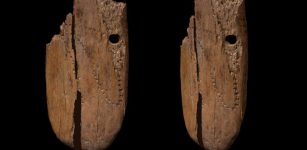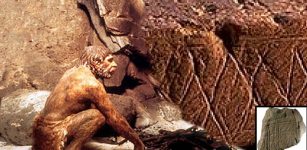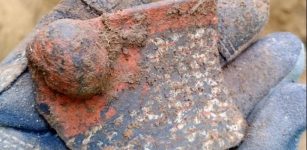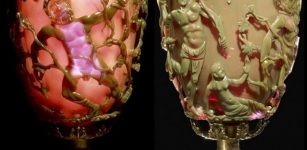Cyclops – First Generation Of Giants Who Were Prisoners Of Tartarus
A. Sutherland - AncientPages.com - The Cyclops are probably best known for their massive, cyclopean masonry and blacksmithing.
Who were these mythical giants?
A first century CE head of a Cyclops, part of the sculptures adorning the Roman Colosseum. Image credit; Steven Lek - CC BY-SA 4.0
This first race of Cyclops – Brontes (thunderer), Sterops (lightener), and Arges (thunderbolt) - were the first generation of Greek giants. They were monstrous children of Gaia, Mother Earth, and Uranus (Ouranos) means 'sky.'
Each of them, as well as their future descendants, such as Polyphemus, we know from the Odyssey, had only a single blazing eye located directly in the middle of the forehead. This eye is said to represent 'the fiery sun.' Each one lived alone with his family on a mountaintop. Their father, Uranus, considered them so shockingly hideous that he threw the Cyclops into Tartarus, the lower region of the Underworld.
Was it only their ugly appearance, which forced the mighty Uranus to get rid of them, or was he simply afraid of their enormous power?
In any case, Uranus believed that he would never see them again. Freed and again placed in the dungeons of Tartarus, the Cyclops had to stay imprisoned for a very long time.
Mother Gaia and her children knew they must cooperate to fight their father. It was apparent that Uranus hated his offspring and hid them in Gaea's body.
She appealed to the sons for vengeance; Cronus (a Titan) alone responded. He took a sickle and removed his cruel father Uranus' testicles as he approached Gaia. As Uranus lay dying, he cursed his son, saying:
"Cronus, it will come to pass that one of your children will do to you what you have just done to me." Then, with a final shudder, a look of anger and betrayal in his eyes, Uranus died
Cyclops: Image credit: Odilon Redon (1840–1916) - collection: Kröller-Müller Museum - Public Domain
Source: https://artsandculture.google.com/asset/the-cyclops-odilon-redon-1840-1916/mAFMK3NTXaN_RQ?hl=en
A sky and weather god, Zeus, raced to Tartarus to release the imprisoned giants. The Cyclops were free because they worked for Zeus, forging thunderbolts.
Cannibals, Craftsmen And Accomplished Builders
Although they were frightening to look at, these young gods were powerful and brilliant craftsmen and accomplished builders. However, different authors described them in their way.
As we know, most mythologies always present several alternative versions of their stories and figures. In Homer's performance, the Cyclops were lawless cannibals dealing with a pastoral life; later authors made them rude, strong, and stubborn giants, but also the craftsmen of Hephaestus and skilled builders.
The famous Cyclopean walls are supposed to be their incredible legacy. Greeks of the Classical Age believed that only the Cyclops, mythical giants, could have been skilled and strong enough to build such gigantic walls. Other structures, such as the massive fortifications of Argos, Tiryns, and Mycenae, were also attributed to the Cyclops.
Pausanius, (c. AD 110 – c. 180, who lived and worked during the reigns of Roman emperors Hadrian, Pius, and Marcus Aurelius, wrote that:
"Nothing is left of the ruins [of Tiryns] except the wall, built by Cyclops with natural rocks, all so huge that a pair of mules would not even begin to shift the smallest. In ancient times, little stones were fitted to bind the rocks together."
As accomplished blacksmiths, the Cyclops contributed remarkable magical weapons for the gods. At first, they created a formidable thunderbolt for Zeus, the most powerful god of the Olympian pantheon.
With this weapon in the form of a handgun launching a death ray, Zeus was able to win the war against the Titans.
Among the Cyclops' other achievements in weaponry were: Hade's Helmet of Darkness, which made its wearer invisible; Poseidon's Trident, which would later become the emblem for the future god of the sea; and Artemis' magical bow and arrows.
Written by – A. Sutherland AncientPages.com Staff Writer
Updated on May 25, 2023
Copyright © AncientPages.com All rights reserved. This material may not be published, broadcast, rewritten or redistributed in whole or part without the express written permission of AncientPages.com
More From Ancient Pages
-
 Mount’s Bay, Lyonesse, Langarroc: Legendary Submerged Lands And Buried Towns Of Cornwall
Featured Stories | Apr 21, 2022
Mount’s Bay, Lyonesse, Langarroc: Legendary Submerged Lands And Buried Towns Of Cornwall
Featured Stories | Apr 21, 2022 -
 Were Other Humans The First Victims Of The Sixth Mass Extinction?
Evolution | Nov 1, 2023
Were Other Humans The First Victims Of The Sixth Mass Extinction?
Evolution | Nov 1, 2023 -
 Ancient City Filled With Treasures May Be Hidden Underground In South America
Ancient Mysteries | Jul 20, 2018
Ancient City Filled With Treasures May Be Hidden Underground In South America
Ancient Mysteries | Jul 20, 2018 -
 Archaeologists Discover Previously Unknown Huge Galleries And Petroglyphs In Colorado
Archaeology | Dec 15, 2023
Archaeologists Discover Previously Unknown Huge Galleries And Petroglyphs In Colorado
Archaeology | Dec 15, 2023 -
 Unique discovery of unknown inscription may change the history of scripts as we know it.
News | Aug 23, 2015
Unique discovery of unknown inscription may change the history of scripts as we know it.
News | Aug 23, 2015 -
 Unexpected Discovery Reveals People Arrived In North America 20,000 Years Earlier Than Previously Thought
Archaeology | Jun 5, 2021
Unexpected Discovery Reveals People Arrived In North America 20,000 Years Earlier Than Previously Thought
Archaeology | Jun 5, 2021 -
 Incredible Technology In Mysterious Huashan Caves, China
Civilizations | Feb 10, 2015
Incredible Technology In Mysterious Huashan Caves, China
Civilizations | Feb 10, 2015 -
 Steamship SS Mesaba Sent Warning To RMS Titanic In 1912 – Her Wreck is Now Identified
Archaeology | Sep 27, 2022
Steamship SS Mesaba Sent Warning To RMS Titanic In 1912 – Her Wreck is Now Identified
Archaeology | Sep 27, 2022 -
 How Did Climate Change Impact European Ice Age Humans?
Earth Changes | Aug 21, 2024
How Did Climate Change Impact European Ice Age Humans?
Earth Changes | Aug 21, 2024 -
 41,500-Year-Old Ivory Pendant Is The Oldest Evidence Of Humans Decorating Jewelery In Eurasia
Archaeology | Nov 26, 2021
41,500-Year-Old Ivory Pendant Is The Oldest Evidence Of Humans Decorating Jewelery In Eurasia
Archaeology | Nov 26, 2021 -
 5 Traces Of Ancient Ancestors That Still Exist In All Human Bodies Today
Featured Stories | Jan 23, 2023
5 Traces Of Ancient Ancestors That Still Exist In All Human Bodies Today
Featured Stories | Jan 23, 2023 -
 Is The Hashtag World’s Oldest Symbol And First Communication Attempt?
Ancient Symbols | Apr 27, 2018
Is The Hashtag World’s Oldest Symbol And First Communication Attempt?
Ancient Symbols | Apr 27, 2018 -
 When Science, Spirituality and Magic Meet – Re-Discovering Old Ancient Knowledge
Featured Stories | Feb 18, 2020
When Science, Spirituality and Magic Meet – Re-Discovering Old Ancient Knowledge
Featured Stories | Feb 18, 2020 -
 Fragment Of A Fine Marble Statuette Of Heracles Found In Jezreel Valley, Israel
Archaeology | May 24, 2023
Fragment Of A Fine Marble Statuette Of Heracles Found In Jezreel Valley, Israel
Archaeology | May 24, 2023 -
 Sargon Of Akkad – Prominent Leader Who Rose Out Of Obscurity
Featured Stories | Jun 7, 2019
Sargon Of Akkad – Prominent Leader Who Rose Out Of Obscurity
Featured Stories | Jun 7, 2019 -
 Rare 1,000-Year-Old Viking Wooden Bowl Found By Young Boy
Archaeology | Oct 24, 2022
Rare 1,000-Year-Old Viking Wooden Bowl Found By Young Boy
Archaeology | Oct 24, 2022 -
 Neanderthals Died Out 40,000 Years Ago, But There Has Never Been More Of Their DNA On Earth
Archaeology | Sep 6, 2022
Neanderthals Died Out 40,000 Years Ago, But There Has Never Been More Of Their DNA On Earth
Archaeology | Sep 6, 2022 -
 6,000-Year-Old Discovery Of Artifacts Associated With Ancient Lengyel Culture
Archaeology | Mar 27, 2020
6,000-Year-Old Discovery Of Artifacts Associated With Ancient Lengyel Culture
Archaeology | Mar 27, 2020 -
 The Lycurgus Cup: Fascinating Artifact That Reveals Prehistoric Knowledge Of Nanotechnology
Ancient Technology | Aug 2, 2018
The Lycurgus Cup: Fascinating Artifact That Reveals Prehistoric Knowledge Of Nanotechnology
Ancient Technology | Aug 2, 2018 -
 Amazing Archaeological Discovery In A Secret Underground Structure In Transylvania Could Rewrite Ancient History
Featured Stories | Feb 13, 2024
Amazing Archaeological Discovery In A Secret Underground Structure In Transylvania Could Rewrite Ancient History
Featured Stories | Feb 13, 2024


